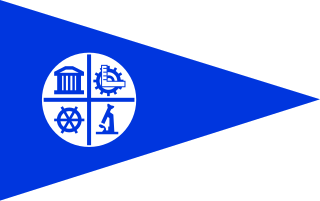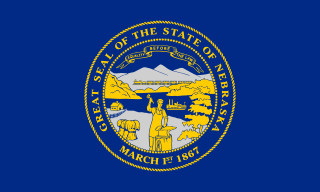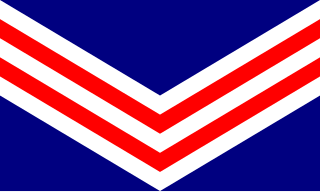
Vexillology is the study of the history, symbolism and usage of flags or, by extension, any interest in flags in general.

The flag of Tennessee displays an emblem on a field of red, with a strip of blue bordered by white on the fly. The emblem in the middle consists of three stars on a blue circle also with a white border. The central emblem portion of the flag has been adopted as the state's unofficial logo, and appears in the logos of some Tennessee-based companies and sports teams. Examples include the First Horizon Bank and the Tennessee Titans.

Whitney Smith Jr. was an American vexillologist. He coined the term vexillology, which refers to the scholarly analysis of all aspects of flags. He was a founder of several vexillology organizations. Smith was a Laureate and a Fellow of the International Federation of Vexillological Associations.

The North American Vexillological Association (NAVA) is a membership organization devoted to vexillology, the study of flags. It was founded in 1967 by American vexillologist Whitney Smith (1940–2016), and others. Its membership of 1,000+ comprises flag scholars, enthusiasts, designers, collectors, conservators, educators, merchants, manufacturers, historians, and hobbyists.

In vexillology, defacement is the addition of a symbol or charge to a flag. For example, the New Zealand flag is the British Blue Ensign defaced with a Southern Cross in the fly.

The flag of Minneapolis is the official municipal flag of Minneapolis, Minnesota.

The flag of Birmingham was designed by Idyl King Sorsby for the occasion of the semicentennial of the city of Birmingham, Alabama in 1921. The flag was officially adopted as the city's flag on August 18, 1925.

The municipal flag of Buffalo is the official banner of the city of Buffalo, New York. The navy blue flag contains a large central emblem consisting of the city seal with 13 "electric flashes" and interspaced 5-pointed white stars emanating from it.

American City Flags is a special double volume issue of Raven: A Journal of Vexillology, a peer-reviewed journal published by the North American Vexillological Association. It is the first comprehensive work on the subject, documenting the municipal flags of the largest 100 U.S. cities, all 50 state capitals, and at least two cities in each state. Each article describes in detail the flag's design, adoption date, proportions, symbolism, selection, designer, and predecessors.

The flag of the state of Nebraska is a blue rectangular cloth charged with a variation of the Nebraskan state seal. The current design was commissioned in 1925, when the Nebraska legislature passed a bill stating that the flag would consist of the state seal in gold and silver on a field of blue.

The Russian Bear is a widespread symbol for Russia, used in cartoons, articles and dramatic plays since as early as the 16th century, and relating alike to the Russian Empire, the Russian Provisional Government and Russian Republic, the Soviet Union, and the present-day Russian Federation.

The Great Waters Association of Vexillology is an organization devoted to vexillology, the scientific study of flags. GWAV has a particular focus on flags of the Midwestern United States.

Frederick Gordon Brownell was a South African herald, vexillologist, and genealogist.

Alfred Znamierowski was a Polish vexillologist, heraldist, illustrator, and journalist. During his career he published several books and designed hundreds of coats of arms, flags, banners and seals for over 200 different municipalities and institutions.

The Macedonian Heraldic Society (MHS) is the only professional body in the field of heraldry, vexillology, phaleristics, chivalristics and nobiliar issues in North Macedonia. The society was founded on 2 July 2003 in Skopje under the name Macedonian Heraldry Society, and changed to its current name in 2018.

The Southern African Vexillological Association (SAVA) was formed in November 1990 to promote vexillology in Southern Africa. Members of the association are drawn mainly from flag manufacturers, collectors, military historians and generally anyone with an interest in flags. SAVA became a member of the International Federation of Vexillological Associations (FIAV) at the 14th International Congress of Vexillology held in Barcelona in 1991 and was the host of the 17th International Congress of Vexillology which was held in Cape Town in August 1997.

The municipal flag of Provo, Utah, United States, features the city's logo on a light blue field. It was adopted on January 6, 2015, after a multi-year debate to replace the previous one. The former flag, adopted in 1989, was ridiculed in particular for its perceived ugliness and its similarity to the Centrum logo, and was voted one of the worst American city flags by the North American Vexillological Association (NAVA).

The flag of Sioux Falls, South Dakota, consists of a zigzag pattern of thin white and blue lines, which divides an upper blue portion and a lower pinkish-red portion, and a yellow sun in the upper left corner. The zigzag represents the namesake falls of the Big Sioux River. The blue color and the sun allude to the flag of South Dakota. The pinkish-red portion represents the Sioux Quartzite nearby. The upward direction of the design represents the growth of Sioux Falls. The red, white and blue colors included in the flag are also a reference to the flag of the United States while maintaining city and state pride.

The flag of Anchorage, Alaska, was adopted by the city of Anchorage in 1973. It is a field of yellow with the seal of the city, which features a blue anchor in the foreground as well as a blue airplane, yellow sun, and yellow sailboat in the background. The words "ANCHORAGE ALASKA" are also present.

The flag of Burlington, Vermont was adopted by the Burlington city council on November 27, 2017 during the mayorship of Miro Weinberger. It is five horizontal, zig-zag stripes of blue, white, green, white, and blue.



















